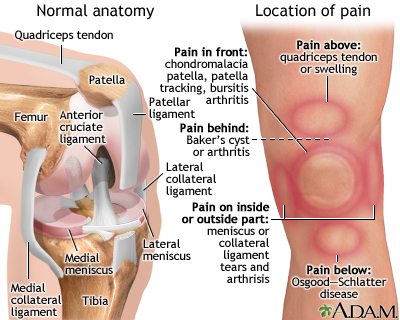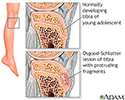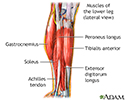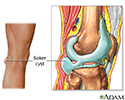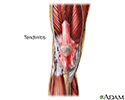Knee pain
Pain - knee
Knee pain is a common symptom in people of all ages. It may start suddenly, often after an injury or exercise. Knee pain also may begin as a mild discomfort, then slowly get worse.
Causes
Knee pain can have different causes. Being overweight puts you at greater risk for knee problems. Overusing your knee can trigger knee problems that cause pain. If you have a history of arthritis, it could also cause knee pain.
Here are some common causes of knee pain:
Medical conditions
-
Arthritis
. Including
rheumatoid arthritis
,
osteoarthritis
,
lupus
, and
gout
.
Arthritis
Arthritis is inflammation of one or more joints. A joint is the area where 2 bones meet. There are more than 100 different types of arthritis....
 ImageRead Article Now Book Mark Article
ImageRead Article Now Book Mark ArticleRheumatoid arthritis
Rheumatoid arthritis (RA) is a long-term disease. It leads to inflammation of the joints and surrounding tissues. It can also affect other organs....
 ImageRead Article Now Book Mark Article
ImageRead Article Now Book Mark ArticleOsteoarthritis
Osteoarthritis (OA) is the most common joint disorder. It is due to aging and wear and tear on a joint.
 ImageRead Article Now Book Mark Article
ImageRead Article Now Book Mark ArticleLupus
Systemic lupus erythematosus (SLE) is an autoimmune disease. In this disease, the body's immune system mistakenly attacks healthy tissue. It can af...
 ImageRead Article Now Book Mark Article
ImageRead Article Now Book Mark ArticleGout
Gout is a type of arthritis. It occurs when uric acid builds up in blood and causes inflammation in the joints. Acute gout is a painful condition th...
 ImageRead Article Now Book Mark Article
ImageRead Article Now Book Mark Article -
Baker's cyst
. A fluid-filled swelling behind the knee that may occur with swelling (inflammation) from other causes, like arthritis.
Baker's cyst
Baker cyst is a buildup of joint fluid (synovial fluid) that forms a cyst behind the knee.
 ImageRead Article Now Book Mark Article
ImageRead Article Now Book Mark Article -
Cancers that either spread to your bones or begin in the
bones
Bones
A bone tumor is an abnormal growth of cells within a bone. A bone tumor may be cancerous (malignant) or noncancerous (benign).
 ImageRead Article Now Book Mark Article
ImageRead Article Now Book Mark Article -
Osgood-Schlatter disease
Osgood-Schlatter disease
Osgood-Schlatter disease is a painful swelling of the bump on the upper part of the shinbone, just below the knee. This bump is called the anterior ...
 ImageRead Article Now Book Mark Article
ImageRead Article Now Book Mark Article -
Infection in the bones of the knee
Infection in the bones of the knee
Osteomyelitis is a bone infection. It is mainly caused by bacteria or other germs.
 ImageRead Article Now Book Mark Article
ImageRead Article Now Book Mark Article -
Infection in the knee joint
Infection in the knee joint
Septic arthritis is inflammation of a joint due to a bacterial or fungal infection. Septic arthritis that is due to the bacteria that cause gonorrhe...
Read Article Now Book Mark Article
Injuries and overuse
-
Bursitis
. Inflammation from repeated pressure on the knee, such as kneeling for a long time, overuse, or injury.
Bursitis
Bursitis is the swelling and irritation of a bursa. A bursa is a fluid-filled sac that acts as a cushion between a muscles, tendons, and bones....
 ImageRead Article Now Book Mark Article
ImageRead Article Now Book Mark Article -
Dislocation of the kneecap
Dislocation of the kneecap
Kneecap dislocation occurs when the triangle-shaped bone covering the knee (patella) moves or slides out of place. The problem usually occurs toward...
 ImageRead Article Now Book Mark Article
ImageRead Article Now Book Mark Article - Fracture of the kneecap or other bones
-
Iliotibial band syndrome
. Injury to the thick band that runs from your hip to the outside of your knee.
Iliotibial band syndrome
IT band syndrome - aftercare; Iliotibial band friction syndrome - aftercare
Read Article Now Book Mark Article -
Pain in the front of your knee
around the kneecap
Pain in the front of your knee
Anterior knee pain is pain that occurs at the front and center of the knee. It can be caused by many different problems, including:Chondromalacia of...
 ImageRead Article Now Book Mark Article
ImageRead Article Now Book Mark Article -
Torn ligament. An
anterior cruciate ligament (ACL)
injury, or
medial collateral ligament (MCL)
injury may cause bleeding into your knee, swelling, or an unstable knee.
Anterior cruciate ligament (ACL)
An anterior cruciate ligament injury is the over-stretching or tearing of the anterior cruciate ligament (ACL) in the knee. A tear may be partial or...
 ImageRead Article Now Book Mark Article
ImageRead Article Now Book Mark ArticleMedial collateral ligament (MCL)
Medial collateral ligament injury - aftercare; MCL injury - aftercare; Lateral collateral ligament injury - aftercare; LCL injury - aftercare...
 ImageRead Article Now Book Mark Article
ImageRead Article Now Book Mark Article - Torn cartilage (a meniscus tear ). Pain felt on the inside or outside of the knee joint.
-
Strain
or
sprain
. Minor injuries to the ligaments caused by sudden or unnatural twisting.
Strain
A strain is when a muscle is stretched too much and tears. It is also called a pulled muscle. A strain is a painful injury. It can be caused by an...
 ImageRead Article Now Book Mark Article
ImageRead Article Now Book Mark ArticleSprain
A sprain is an injury to the ligaments around a joint. Ligaments are strong, flexible fibers that hold bones together. When a ligament is stretched...
 ImageRead Article Now Book Mark Article
ImageRead Article Now Book Mark Article
Home Care
Simple causes of knee pain often clear up on their own while you take steps to manage your symptoms. If knee pain is caused by an accident or injury, you should contact your health care provider.
If your knee pain has just started and is not severe, you can:
- Rest and avoid activities that cause pain. Avoid putting weight on your knee.
- Apply ice. First, apply it every hour for up to 15 minutes. After the first day, apply it at least 4 times per day. Cover your knee with a towel before applying ice. DO NOT fall asleep while using ice. You can leave it on too long and get frostbite.
- Keep your knee raised as much as possible to bring down any swelling.
- Wear an elastic bandage or elastic sleeve, which you can buy at most pharmacies. This may reduce swelling and provide support.
- Take ibuprofen (Motrin) or naproxyn (Aleve) for pain and swelling. Acetaminophen (Tylenol) can help relieve pain, but not swelling. Talk to your provider before taking these medicines if you have medical problems, or if you have taken them for more than a day or two.
- Sleep with a pillow underneath or between your knees.
Follow these general tips to help relieve and prevent knee pain:
- Always warm up before exercising and cool down after exercising. Stretch the muscles in the front of your thigh (quadriceps) and in the back of your thigh (hamstrings).
- Avoid running down hills -- walk down instead.
- Bicycle, or better yet, swim instead of run.
- Reduce the amount of exercise you do.
- Run on a smooth, soft surface, such as a track, instead of on cement or pavement.
- Lose weight if you are overweight. Every pound (1/2 kilogram) that you are overweight puts about 5 extra pounds (2.25 kilograms) of pressure on your kneecap when you go up and down stairs. Ask your provider for help losing weight.
- If you have flat feet, try special shoe inserts and arch supports (orthotics).
- Make sure your running shoes are well made, fit well, and have good cushioning.
Further steps for you to take may depend on the cause of your knee pain.
When to Contact a Medical Professional
Call your health care provider if:
- You cannot bear weight on your knee
- You have severe pain, even when not bearing weight
- Your knee buckles, clicks, or locks
- Your knee is deformed or misshapen
-
You have a
fever
, redness or warmth around the knee, or a lot of swelling
Fever
Fever is the temporary increase in the body's temperature in response to a disease or illness. A child has a fever when the temperature is at or abov...
 ImageRead Article Now Book Mark Article
ImageRead Article Now Book Mark Article - You have pain, swelling, numbness, tingling, or bluish discoloration in the calf below the sore knee
- You still have pain after 3 days of home treatment
What to Expect at Your Office Visit
Your health care provider will perform a physical exam, and look at your knees, hips, legs, and other joints.
Your provider may do the following tests:
- Joint fluid culture (fluid taken from the knee and examined under a microscope)
-
X-ray of the knee
X-ray of the knee
A bone x-ray is an imaging test to look at the bones.
 ImageRead Article Now Book Mark Article
ImageRead Article Now Book Mark Article -
MRI of the knee
if a ligament or meniscus tear could be the cause
MRI of the knee
A knee MRI (magnetic resonance imaging) scan uses energy from strong magnets to create pictures of the knee joint and muscles and tissues. An MRI doe...
Read Article Now Book Mark Article - CT scan of the knee
Your provider may inject a steroid into your knee to reduce pain and inflammation.
You may need to learn stretching and strengthening exercises. You also may need to see a podiatrist to be fitted for orthotics.
In some cases, you may need surgery.
References
Huddleston JI, Goodman SB. Hip and knee pain. In: Firestein GS, Budd RC, Harris ED Jr, et al, eds. Kelley's Textbook of Rheumatology . 9th ed. Philadelphia, PA: Elsevier Saunders; 2012:chap 48.
Niska JA, Petrigliano FA, McAllister DR. Anterior cruciate ligament injuries (Including Revision). In: Miller MD, Thompson SR, eds. DeLee and Drez's Orthopaedic Sports Medicine . 4th ed. Philadelphia, PA: Elsevier Saunders; 2015:chap 98.
-
Leg pain (Osgood-Schlatter) - illustration
Leg pain in older children or young adolescents can occur for many reasons. An Osgood-Schlatter lesion results from continued trauma to the anterior tibial bone and causes a visible lump below the knee.
Leg pain (Osgood-Schlatter)
illustration
-
Lower leg muscles - illustration
The muscular components of the lower leg include the gastrocnemius, soleus, peroneus longus, tibialis anterior, extensor digitorum longus, and the Achilles tendon.
Lower leg muscles
illustration
-
Knee pain - illustration
The location of knee pain can help identify the problem. Pain on the front of the knee can be due to bursitis, arthritis, or softening of the patella cartilage as in chondromalacia patella. Pain on the sides of the knee is commonly related to injuries to the collateral ligaments, arthritis, or tears to the meniscuses. Pain in the back of the knee can be caused by arthritis or cysts, known as Baker’s cysts. Baker’s cysts are an accumulation of joint fluid (synovial fluid) that forms behind the knee. Overall knee pain can be due to bursitis, arthritis, tears in the ligaments, osteoarthritis of the joint, or infection. Instability, or giving way, is also another common knee problem. Instability is usually associated with damage or problems with the meniscuses, collateral ligaments, or patella tracking.
Knee pain
illustration
-
Baker's cyst - illustration
A Baker cyst is seen as a swelling behind the knee. It forms when joint fluid collects behind the knee. The swelling may be due from inflammation or from other causes, like arthritis. The condition can be seen in both adults and children.
Baker's cyst
illustration
-
Tendinitis - illustration
Tendinitis is inflammation, irritation, and swelling of a tendon, which is the fibrous structure that joins muscle to bone. Tendinitis pain in the knee is located in the front of the knee. The pain gets worse when going up and down stairs or inclines. Tendinitis knee pain can happen in runners, skiers, and cyclists.
Tendinitis
illustration
-
Leg pain (Osgood-Schlatter) - illustration
Leg pain in older children or young adolescents can occur for many reasons. An Osgood-Schlatter lesion results from continued trauma to the anterior tibial bone and causes a visible lump below the knee.
Leg pain (Osgood-Schlatter)
illustration
-
Lower leg muscles - illustration
The muscular components of the lower leg include the gastrocnemius, soleus, peroneus longus, tibialis anterior, extensor digitorum longus, and the Achilles tendon.
Lower leg muscles
illustration
-
Knee pain - illustration
The location of knee pain can help identify the problem. Pain on the front of the knee can be due to bursitis, arthritis, or softening of the patella cartilage as in chondromalacia patella. Pain on the sides of the knee is commonly related to injuries to the collateral ligaments, arthritis, or tears to the meniscuses. Pain in the back of the knee can be caused by arthritis or cysts, known as Baker’s cysts. Baker’s cysts are an accumulation of joint fluid (synovial fluid) that forms behind the knee. Overall knee pain can be due to bursitis, arthritis, tears in the ligaments, osteoarthritis of the joint, or infection. Instability, or giving way, is also another common knee problem. Instability is usually associated with damage or problems with the meniscuses, collateral ligaments, or patella tracking.
Knee pain
illustration
-
Baker's cyst - illustration
A Baker cyst is seen as a swelling behind the knee. It forms when joint fluid collects behind the knee. The swelling may be due from inflammation or from other causes, like arthritis. The condition can be seen in both adults and children.
Baker's cyst
illustration
-
Tendinitis - illustration
Tendinitis is inflammation, irritation, and swelling of a tendon, which is the fibrous structure that joins muscle to bone. Tendinitis pain in the knee is located in the front of the knee. The pain gets worse when going up and down stairs or inclines. Tendinitis knee pain can happen in runners, skiers, and cyclists.
Tendinitis
illustration
Review Date: 11/26/2014
Reviewed By: C. Benjamin Ma, MD, Assistant Professor, Chief, Sports Medicine and Shoulder Service, UCSF Department of Orthopaedic Surgery, San Francisco, CA. Also reviewed by David Zieve, MD, MHA, Isla Ogilvie, PhD, and the A.D.A.M. Editorial team.

